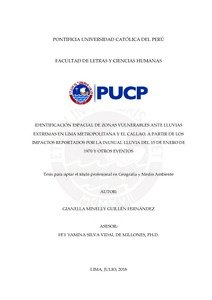| dc.contributor.advisor | Silva Vidal de Millones, Fey Yamina | es_ES |
| dc.contributor.author | Guillén Fernández, Gianella Minelly | es_ES |
| dc.date.accessioned | 2018-07-25T20:54:09Z | es_ES |
| dc.date.available | 2018-07-25T20:54:09Z | es_ES |
| dc.date.created | 2018 | es_ES |
| dc.date.issued | 2018-07-25 | es_ES |
| dc.identifier.uri | http://hdl.handle.net/20.500.12404/12340 | |
| dc.description.abstract | La ciudad de Lima, a partir de la década de los 80's, ha venido experimentando un
crecimiento urbano exponencial y desordenado, estas condiciones y la falta de
seguridad en las construcciones de viviendas incrementan la vulnerabilidad frente a
diversos peligros como terremotos, incendios, tsunamis y también frente a lluvias,
siendo estas últimas poco estudiadas y no por ello menos importantes.
El presente estudio busca implementar nuevas herramientas y métodos para realizar
un modelamiento espacial que nos permita identificar las zonas más vulnerables frente
a una lluvia extrema en Lima Metropolitana, así también, identificar la tipología
predominante de las viviendas en zonas más vulnerables.
Esta investigación utiliza como principal fuente, reportes históricos de una de las
lluvias atípicas más catastróficas que ha ocurrido en Lima, la del 15 de enero de
1970 coloquialmente conocida como el “diluvio setentero”, quedando así la ciudad en
condiciones críticas. Desde entonces no ha vuelto a ocurrir una lluvia
de similar magnitud, pudiendo ser el evento del siglo; lo que significa que volverá a
ocurrir y por ello, se deben tomar las medidas de prevención necesarias. No se debe
subestimar la fuerza erosiva del agua, siendo que vivimos en una ciudad sin
infraestructura para la evacuación del agua y con viviendas poco estructuradas para
este tipo de eventos.
Para entender las zonas más vulnerables, identificar los patrones y características de
estos espacios, se utilizó el programa Maxent y un conjunto de herramientas de análisis
espacial, como los sistemas de información geográfica. Se complementó el análisis con
un registro fotográfico para corroborar los resultados.
Esta investigación contribuirá como una línea de base a los tomadores de decisiones y
sugerirá algunas acciones para prevenir los impactos de las lluvias intensas en la
ciudad capital.
Los resultados indican que la vulnerabilidad se presenta en la mayoría de las periferias
de Lima Metropolitana y el Callao, así como, en los distritos de tradición histórica. La
tipología de viviendas que predomina en las zonas vulnerables corresponde en su
mayoría a viviendas de techo y pared de adobe cuya forma de techo es plana. | es_ES |
| dc.description.abstract | The city of Lima, since the 80's, has been experiencing an exponential and disorganized
urban growth. These conditions and the lack of security in housing constructions
increase vulnerability to various hazards such as earthquakes, fires, tsunamis and
rains. These rains are little studied but not least important.
The present study searches to implement new tools and methods to perform a spatial
modeling that allows us to identify the most vulnerable areas in the face of extreme
rain in Metropolitan Lima, in the same way to identify the predominant type of
housing in the most vulnerable areas.
This research uses as main source, reports the historical one of the most catastrophic
atypical rains that has occurred in Lima, on January 15, 1970, colloquially known as the
“diluvio setentero”, thus leaving the city in critical conditions. Since then, there has not
been a rain of similar magnitude again, which could be the event of the century; which
means that it will happen again. Therefore, the necessary prevention measures must
be taken. The erosive force of water should not be underestimated, in face that we live
in a city without infrastructure for water evacuation and with poorly structured
housing for this type of event.
To understand the most vulnerable areas, to identify the patterns and characteristics of
these spaces, we used the program called Maxent and a set of spatial analysis tools,
such as geographic information systems. The analysis was complemented with a
photographic record to corroborate the results.
This investigation will contribute as a baseline to the decision makers and suggest
some actions to prevent the impacts of heavy rains in the capital city.
The results indicate that the vulnerability is present in most of the peripheries of
Metropolitan Lima and Callao, as well as in the districts of historical tradition. The
typology of dwellings that predominates in the vulnerable zones corresponds in its
majority to dwellings of roof and adobe wall whose roof form is flat. | es_ES |
| dc.language.iso | spa | es_ES |
| dc.publisher | Pontificia Universidad Católica del Perú | es_ES |
| dc.rights | Atribución-NoComercial 2.5 Perú | * |
| dc.rights | info:eu-repo/semantics/openAccess | es_ES |
| dc.rights.uri | http://creativecommons.org/licenses/by-nc/2.5/pe/ | * |
| dc.subject | Precipitación atmosférica--Perú--Lima | es_ES |
| dc.subject | Precipitación atmosférica--Perú--Callao | es_ES |
| dc.subject | Barrios marginales--Perú--Lima | es_ES |
| dc.subject | Barrios marginales--Perú--Callao | es_ES |
| dc.title | Identificación espacial de zonas vulnerables ante lluvias extremas en Lima Metropolitana y el Callao, a partir de los impactos reportados por la inusual lluvia del 15 de enero de 1970 y otros eventos | es_ES |
| dc.type | info:eu-repo/semantics/bachelorThesis | es_ES |
| thesis.degree.name | Licenciado en Geografía y Medio Ambiente | es_ES |
| thesis.degree.level | Título Profesional | es_ES |
| thesis.degree.grantor | Pontificia Universidad Católica del Perú. Facultad de Letras y Ciencias Humanas | es_ES |
| thesis.degree.discipline | Geografía y Medio Ambiente | es_ES |
| renati.discipline | 532036 | es_ES |
| renati.level | https://purl.org/pe-repo/renati/level#tituloProfesional | es_ES |
| renati.type | http://purl.org/pe-repo/renati/type#tesis | es_ES |
| dc.publisher.country | PE | es_ES |
| dc.subject.ocde | https://purl.org/pe-repo/ocde/ford#5.07.00 | es_ES |






